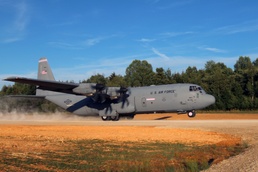
HOHENFELS, Germany - A joint team from the U.S. Air Force and the U.S. Army conducted the first C-130 landing at Joint Multinational Readiness Center in over two years, July 29.
The test landing is a precursor to Exercise Swift Response 15, which will occur at Hohenfels in August.
“Today certifies and validates the landing sequence that is going to take place as part of Swift Response,” said Capt. Matthew D. Pride, an exercise planner for JMRC. “The intent is to have 42 landing sequences. This was an opportunity to touchdown before final execution.”
Exercise Swift Response 15 will include loading and air-dropping approximately 1,400 multinational service members within a four-hour window.
Pilots of 37th Airlift Squadron, 86th Airlift Wing flew in from Ramstein Air Base, Germany, and performed three successful landing and take-off cycles with the C-130.
“It was a successful landing, and [the Short Take Off Landing strip] is ready to support C-130s.” Air Force Master Sgt. David Hough, airfield manager, 435th Contingency Response Group, Ramstein Air Base.
“This project has been a year in the making,” said Major Charles A. Pinto, Texas Army National Guard, Troop Construction Program, JMRC. “The purpose [of this revamped STOL] is to integrate airfield operations into training with multinational and allied partners.”
STOL was a small landing strip until June 2015 when it was extended by the 201st Red Horse Squadron, Pennsylvania Air National Guard, to support larger aircraft.
“It was the Air National Guard that did all the work, they did the design and then started the construction,” said Pinto. “JMRC brought them here and made sure they were supported. It was good to see all the hard work come together.”
STOL has been suspended for the last two years from landing C-130 aircraft. More recently, the airstrip was only able to support Unmanned Aerial Vehicles and helicopters landing.
The airstrip had to be surveyed and signed off by 86th Airfield commander at Ramstein, and the landing and take-off was the final phase to clear the airstrip.
“It’s huge,” said Hough of the additional capabilities of the new airstrip. “This is the only dirt, or semi-prepared, landing zone in Germany.”
Landing on a semi-prepared strip is a requirement for operations to stay current, and this field will now provide that opportunity for Allies, Partners and American forces to improve interoperability of air operations.
“This strip enhances the capability of the training center and allows us to bring in a complex set of training exercises and scenarios,” said Pride.
These exercises are part of NATO troops training for brigade-size operations to prepare to respond to a global crisis. Exercises are conducted to improve interoperability and provide U.S./NATO training while building relationships and effectiveness as part of Joint Multinational Training Command.
“In terms of validating global response forces as not just a principal, but to validate capabilities to project anywhere in the world, seasoning the STOL is a critical objective for the exercise,” said Pride. “It has been quite a year and a lot of units have come through. To see the C-130 land here today is quite an accomplishment.”